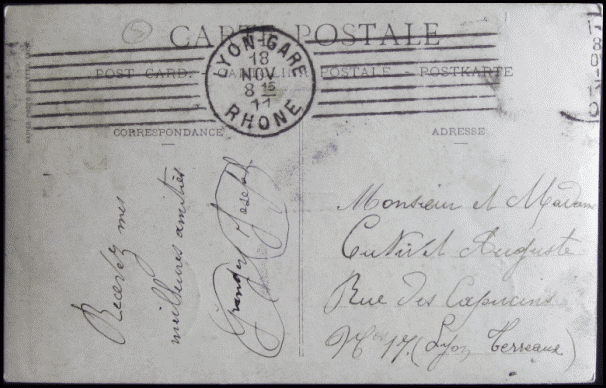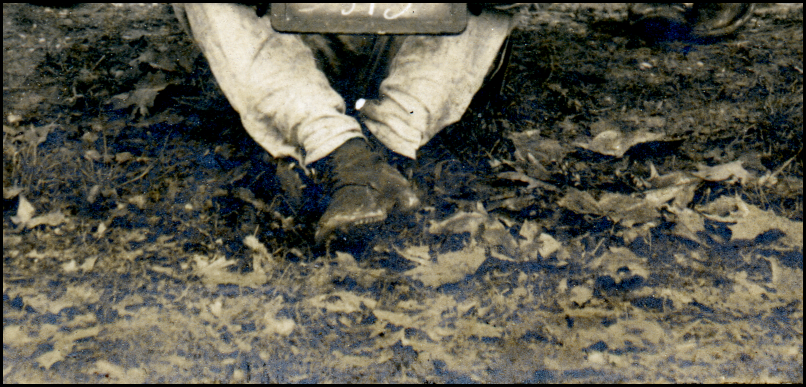The variety of situations seems endless. If millions of men posed in uniform at the beginning of the 20th century, they were ingenious in their different attitudes, making each image unique. And without realising it, they have made us rack our brains to make what is visible speak for itself.

- Which regiment?
It is very difficult to determine the unit of these eight men. The numbers on the kepis are illegible. One man has ironed his kepi with chalk, but the number is slightly raised and illegible. It seems to be made up of two numbers, but it’s difficult to say more than that. There are no numbers on the burgers.

The slate isn’t much help: « Honneur aux anciens, 313 ». We might even wonder whether they were infantrymen, as the colours of the kepis were difficult to discern.
A further difficulty is how to interpret this « 313 »? 313rd RI? Another 313 days to go?

- The mysterious « 313«
The first and most practical idea would be that it’s the number of the regiment. The words ‘Honneur aux anciens’ (‘Honouring old hands’) could be interpreted as meaning that these men were doing a period of training with the 313rd RI. Given that the number on the kepi was not changed for these few days, chalk 313 would be a way of highlighting it. This hypothesis could be confirmed in three ways:
- Was the 313rd RI formed in November 1911? A priori no, as reserve units were only formed every other year, and rarely at such a late date when the training of the new class was in full swing.
- Was Joseph Granger, the author of the card, called up for an exercise period during this period? We would need to access his service record to find out… but first we would need to know which recruiting office he belonged to. There is more than one Granger Joseph.
- Was the 113th RI, which formed the reserve regiment 313, in Lyon? This regiment was in Blois. Was the 313rd RI in Lyon (on manoeuvres) in November 1911? Very unlikely indeed.
These three elements show the weakness of the basic idea. The second hypothesis will prove that these were not reservists from the 313rd RI.

Generally, the men indicated on their clothing the number of days they had left before their liberation. In this case, only 313 days remained. This indication on the kepi is rarer, but it may be explained by the impossibility of writing it on the burgundy as is usually done on the capote. Chalk on an unbleached white burgundy would not help. This number of days is sometimes found on gaiters.

Dated 1911, this gives us men of class 1909 (drafted in 1910, released at the end of September 1912). Taking the date of discharge as 25 September 1912, this gives a date of 8 November 1910. Problem: this is the date the card was posted. There are several possibilities: was the image posted on the day it was taken and purchased? Was the man released one or more days before 25 September (which is possible)? Did his planned release date not correspond to the actual release date? There were no errors in the calculations, as the spreadsheets provided a quick and reliable answer.
The words « Honour to the veterans » could then be understood as an allusion to the fact that these men were now the veterans at the barracks, since the departure of the class of 1910 a little over a month earlier.
- In working clothes
The image itself is not very rich. These men are dressed for work (fatigues and trousers).

They may be in the grounds of a barracks, on a training ground or in a public square, but it’s hard to tell because there are so few clues as to where they are.

Admittedly, the card is cancelled Lyon gare, but this does not indicate that the man who posted it was stationed there. Only the blurred background and the few visible elements (buildings, a pole (?) in an open space, a smoky factory chimney on the right in the least clear part of the image) would allow us to tell, but in the absence of clear clues the ratio of search time to probability of finding something is very slim.

It should be noted that the mechanical imprint gave the date on which the card was posted, despite the fact that the stamp had been removed. Otherwise, the three stamps in the photo would have been very difficult to find. The missing stamp is 5 centimes, as the text respects the rule of 5 words + signature.
You can’t see any shadows on the ground. Is it a grey autumn day? In any case, we’re at the moment when the leaves on the trees have finished falling: there are some on the ground, but there are still some visible on the branches. If the men had been on duty to collect them, they would probably have been posing with wheelbarrows and brooms!

- Conclusion (1)
This image is far from having told us everything it could. There is still the possibility of Joseph Granger, but there are so many homonyms that the search is very uncertain, especially in the absence of a precise location or even a degree of kinship with the card’s recipients. Circumstances, place, people, units… not finding anything is one of the rules to accept in this type of research.
- Update
Thibaut Vallé has pursued the trail of Joseph Granger, using every little detail of this document, despite its paucity of clues. Here’s what he came up with.
Heading for Vasselin, a small rural village in Isère. On 26 December 1886, Marie Joséphine Vigneu, wife of GRANGER, gave birth to Félicité. Auguste CUTIVET was born in the same village on 30 September 1886. So there are two names on the map, in the same commune. The two records are opposite each other in the register.

It is possible to confirm that the trail is the right one by looking to see if there is a Granger son.
Same place, same register, but a few years later, on 2 August 1889: Marie Joséphine gave birth to Joseph Granger, Félicité’s brother.
In 1906, Auguste was called up for military service. His service number was 753 at the Bourgoin recruiting office. The interesting thing about his extensive service record is the address given from April 1911. Auguste, who married Félicité in 1910, lived at 17 rue des Capucins in Lyon. This is the name and address of the card’s recipient!

As indicated in the article, Joseph Granger was born in 1889, and was in the 1909 class at the Bourgoin recruitment office. His registration number was 1456. He was an artilleryman in the 54th RAC when he wrote these lines.
Both Auguste and Joseph endured the Great War very painfully, with multiple injuries. The medical assessment on Joseph’s card, « Sick more impotent than an amputee », could not be clearer.
- Identification on the photograph
A detail from Joseph Granger’s registration card helps to identify where he is on the photograph: his eyebrows and hair are blond. Only one man has very light hair, a round chin and a rather oval face with a small mouth:

- Conclusion (2)
In 1911, Joseph wrote to his sister and brother-in-law in Lyon while he was a gunner serving in the 54th RAC. Thanks to the discovery of his service record, it has been possible to determine with some confidence where he is on the photograph.
- Acknowledgements:
To Thibaut Vallé who managed to find all the people mentioned on this photo card.
- Source:
Archives départementales de l’Isère
https://archives.isere.fr/
5 E 526/9 : commune de Vasselin. Naissances, mariages et décès. Coll. Départementale (1883-1892), vue 16/136.
1 R 1432_03 : fiche matricule de Antoine Auguste Cutivet, classe 1906, matricule 753 au bureau de recrutement de Bourgoin, vue 75/124.
1 R 1476_5 : fiche matricule de Joseph Granger, classe 1909, matricule 1456 au bureau de recrutement de Bourgoin, vue 95/161.
